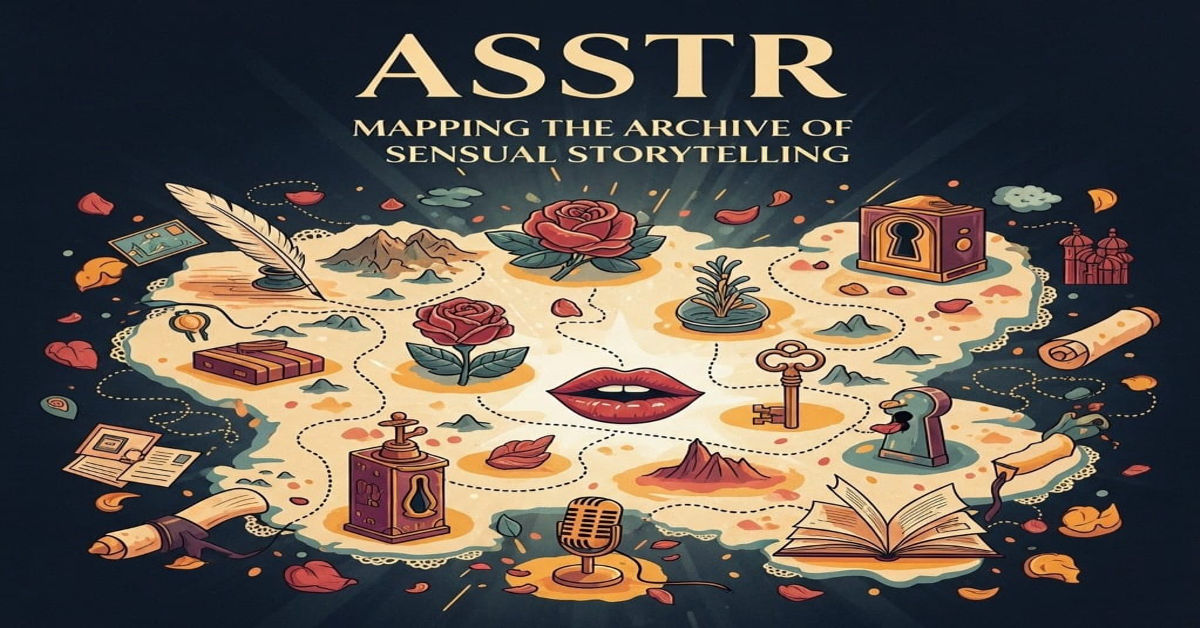ASSTR also known as the Alt Sex Stories Text Repository is one of the most iconic digital archives created during the early internet era. Unlike entertainment-driven platforms of today, ASSTR was built with a single focus: to preserve and provide free access to erotic literature. Its unique contribution was not in flashy design or multimedia integration but in its ability to host a vast and diverse collection of stories written by people from around the globe. The platform became a trusted space for exploration providing anonymity for authors and a sense of discovery for readers.
The platform became more than a collection of stories it represented a cultural shift. ASSTR showed that the internet could act as a democratic space for creative writing where anyone could publish without approval from publishers or editors. This freedom helped normalize online erotic literature as a legitimate form of artistic expression and encouraged thousands of amateur and professional writers to explore their creativity in new ways.
The Origins and History of ASSTR
The roots of ASSTR can be traced back to the 1990s, when the internet was still in its infancy. Much of the early online community revolved around Usenet newsgroups, where people exchanged messages and shared files. Erotic literature found a home there, but the problem was impermanence. Once discussions moved on, stories often disappeared. Enthusiasts recognized the need for a more permanent archive, and ASSTR was born out of this need.
During its early years, ASSTR was revolutionary because it organized stories into an accessible and structured system. Contributors were able to upload works without censorship, giving them the freedom to explore genres and themes not typically supported by mainstream publishers. Over time, the archive attracted a global audience, becoming one of the largest and most enduring repositories for erotic fiction. Its history is deeply tied to the growth of digital culture, serving as a reminder of how early internet users built communities to preserve creativity.
Evolution of Online Erotic Literature Communities
As internet technology advanced, the landscape of erotic literature expanded. Blogs, fanfiction platforms, and interactive forums began to emerge, providing spaces where stories could be shared with feedback loops, reviews, and discussions. These platforms emphasized interactivity, unlike ASSTR, which prioritized long-term preservation. While ASSTR remained static in its design, the growing number of community-driven websites showed the demand for engagement and conversation around storytelling.
Despite the rise of interactive platforms, ASSTR retained its value. Its archival structure offered permanence in a digital world where content often vanished. This stability gave it an advantage for readers and researchers interested in revisiting material years after it was published. By focusing on longevity, ASSTR complemented newer communities by serving a different but equally important role. Together, these different types of platforms shaped the way online erotic literature evolved, demonstrating the adaptability of digital storytelling to diverse user needs.
Role of ASSTR in Preserving Creative Writing
One of the most remarkable aspects of ASSTR was its role as a preserver of creative writing. At a time when personal hosting was expensive and often temporary, ASSTR provided a centralized space where authors could ensure their work would endure. Writers from around the world used the platform as a safe space to explore creativity, often experimenting with themes they might never have published under their own names.
The importance of this preservation role goes beyond individual authors. ASSTR became a record of cultural and social shifts in how people expressed sexuality through literature. Stories written decades ago remain accessible, offering insights into changing perspectives and creative styles. By archiving not just popular works but also niche and experimental pieces, ASSTR contributed to a richer understanding of human imagination. In this way, it functioned as both a library for readers and a historical record for digital culture.
Why ASSTR Gained Popularity Worldwide
ASSTR’s global popularity can be attributed to accessibility and inclusivity. Unlike commercial platforms, it allowed people to contribute without financial barriers, making it attractive to writers who might not have otherwise been published. Readers also benefited from free access, discovering stories that reflected diverse perspectives and genres. The ability to remain anonymous added another layer of appeal, as writers could explore topics they might not feel comfortable sharing under their real identities.
The archive also built a reputation for reliability. Once uploaded, stories usually remained available for years, giving readers confidence that they could return to the site and rediscover their favorites. Over time, ASSTR’s international reach grew as it welcomed contributions from across cultures and languages. This diversity enhanced its appeal, turning it into a unique global hub for literature that might otherwise never have reached audiences. The result was a thriving community centered on creativity and free expression.
Why ASSTR Became Globally Popular
| Factor | Contribution |
| Accessibility | Free access for writers and readers worldwide |
| Anonymity | Freedom to publish without personal risk |
| Reliability | Stories archived for long-term use |
| Diversity | Contributions from different cultures and genres |
ASSTR’s popularity highlights the role of inclusivity in building sustainable communities. By lowering barriers to participation, the platform attracted a global user base that valued both anonymity and creativity. Unlike modern paywalled or ad-supported sites, ASSTR’s simplicity and openness allowed it to build trust and loyalty. This demonstrates how accessibility can be as important as advanced features in creating a meaningful and lasting cultural resource.
Technical Structure and Features of ASSTR
ASSTR’s design was minimalist but functional. It relied on a directory-based system where each writer had their own page or folder containing a collection of stories. Files were uploaded as plain text, ensuring compatibility across different devices and operating systems. This approach may seem outdated today, but it was practical at the time, keeping costs low and preserving stories in universally accessible formats.
Navigation was straightforward. Users could browse author directories or use a basic search feature to find specific works. There were no elaborate visuals, multimedia, or interactive tools, but this simplicity served ASSTR’s mission. By avoiding unnecessary complexity, the archive ensured stability and resilience. While its lack of modernization eventually became a disadvantage, the technical structure reflected its role as a long-term repository rather than a social network. This design decision is one of the reasons it managed to remain online for so many years.
Challenges Faced by ASSTR Over the Years
Like many long-standing platforms ASSTR faced several challenges. Financial constraints were one of the biggest issues. Without advertisements or subscription models funding relied on volunteer support and limited resources. Maintaining servers over decades was difficult, especially as the archive grew in size. Another issue was legal pressure, as laws regarding adult content varied greatly across regions, creating uncertainty about long-term sustainability.
Technological stagnation also contributed to its decline. While the internet became increasingly mobile-friendly and interactive, ASSTR remained static, offering little innovation. As a result, younger audiences gravitated toward more modern platforms. The failure of search and registration systems further reduced usability. These challenges collectively limited ASSTR’s ability to remain relevant, despite its enduring value as an archive. They serve as reminders of how critical ongoing investment, modernization, and legal clarity are for digital preservation efforts.
The Decline of ASSTR and User Experiences
By the late 2010s, the decline of ASSTR was evident. Registration systems stopped working reliably, preventing new authors from joining the archive. Search functionality became inconsistent, frustrating readers who depended on it to navigate the vast collection. Many long-time users continued to visit the site out of nostalgia, but the lack of updates left them disappointed compared to its earlier years of activity.
Despite these frustrations, ASSTR retained a loyal following. Some users treated it as a historical archive rather than an active community. The enduring presence of older stories gave it value, even if new content was scarce. This dual identity—as both a fading platform and a cultural archive—illustrates the challenges faced by digital communities as they age. The decline was not merely technical; it represented the difficulty of maintaining enthusiasm and relevance without ongoing development and active community management.
Alternatives and Modern Platforms for Erotic Literature
As ASSTR declined, readers and writers migrated to newer platforms. Blogs allowed authors to publish independently, while fanfiction websites created communities with feedback systems. Adult storytelling platforms also emerged, offering modern interfaces and mobile compatibility. These alternatives introduced interactive features such as comments, ratings, and personalized recommendations, which were absent from ASSTR.
However, these modern platforms came with trade-offs. Many relied on advertising, memberships, or paywalls, making them less universally accessible. Moderation policies were also stricter, which provided safer environments but limited creative freedom. While none of these platforms perfectly replicated ASSTR’s archival model, together they provided alternatives that reflected the evolving needs of digital audiences. The shift illustrates how online literature communities adapt to changing technologies while continuing to support the core value of creative expression.
Modern Alternatives Compared to ASSTR
| Platform Type | Advantages | Limitations |
| Blogs | Author control, flexible design | Requires personal hosting |
| Fanfiction Sites | Interactive, strong communities | May restrict adult themes |
| Adult Story Sites | Modern design, global reach | Often ad-supported or paid |
The variety of alternatives demonstrates that there is no single replacement for ASSTR. Instead, its functions have been divided among multiple platforms, each addressing different aspects of the experience. This diversity reflects the evolving landscape of digital literature, where no single model dominates but many coexist to meet different needs.
Cultural and Social Impact of ASSTR
Beyond its technical role, ASSTR had a profound cultural and social impact. It created a space where individuals could safely explore sexuality, identity, and personal fantasies through literature. For many writers, publishing anonymously on ASSTR was their first opportunity to share deeply personal stories. This creative outlet empowered voices that might otherwise have been silenced by social stigma or lack of access to traditional publishing.
The archive also contributed to community building. Readers and writers connected over shared interests, even if the platform lacked interactive features. ASSTR became a cultural symbol of free expression, influencing later communities and shaping discourse around online erotic literature. From an academic perspective, it stands as a valuable resource for studying how people used digital platforms to navigate and articulate aspects of human intimacy and imagination during the early years of the internet.
Future of Online Erotic Archives
The decline of ASSTR raises questions about the future of digital erotic archives. While the original platform may not fully recover, its legacy inspires new approaches to preservation. Emerging technologies like decentralized hosting and blockchain could provide solutions to censorship and funding issues, ensuring that stories remain accessible without depending on a central authority.
Future archives are likely to integrate modern usability features while retaining the permanence that made ASSTR unique. Advanced search tools, mobile compatibility, and secure storage methods could create a balance between accessibility and long-term preservation. The enduring interest in erotic literature suggests that such platforms will continue to thrive, though they may take new forms. ASSTR’s story serves as both a cautionary tale and a source of inspiration for those building the next generation of digital archives.
Features Likely to Define Future Archives
| Feature | Benefit |
| Decentralized Hosting | Reduces censorship risks |
| Mobile Compatibility | Reaches wider audiences |
| Advanced Search Tools | Enhances discoverability |
| Sustainable Funding Models | Ensures long-term survival |
By combining archival permanence with modern usability, future platforms can address the shortcomings of ASSTR while preserving its spirit. The key will be balancing openness and accessibility with the technical and financial realities of long-term digital preservation.
Conclusion and Final Thoughts
ASSTR remains one of the most influential archives in the history of online literature. Its success was built on accessibility, inclusivity, and permanence, qualities that made it stand out in the early days of the internet. While technological and financial challenges eventually led to its decline, its influence continues to resonate across modern platforms. The archive demonstrated the value of digital preservation and the importance of giving writers freedom to explore creativity without barriers.
The story of ASSTR is ultimately about more than just a website; it is about community, expression, and the preservation of culture in digital spaces. Its legacy endures not only in the stories it preserved but also in the platforms it inspired. For writers, readers, and researchers, ASSTR will always be remembered as a pioneer of digital literature and a symbol of how imagination can thrive in open, inclusive spaces.
FAQs
1. What was ASSTR’s main purpose?
ASSTR was created as an online archive to preserve and provide free access to erotic literature contributed by writers worldwide.
2. Why did ASSTR decline?
The decline resulted from outdated technology, funding difficulties, legal risks, and the inability to modernize features such as search and registration.
3. Are there current alternatives to ASSTR?
Yes, alternatives include fanfiction sites, personal blogs, and adult story platforms. These offer interactivity but often lack ASSTR’s archival permanence.
4. Is ASSTR still accessible?
Parts of the archive are still accessible, but many features no longer function, making navigation difficult and limiting new contributions.
5. What is ASSTR’s cultural significance?
ASSTR played a vital role in preserving digital erotic literature, empowering writers with creative freedom, and shaping the growth of online storytelling communities.







